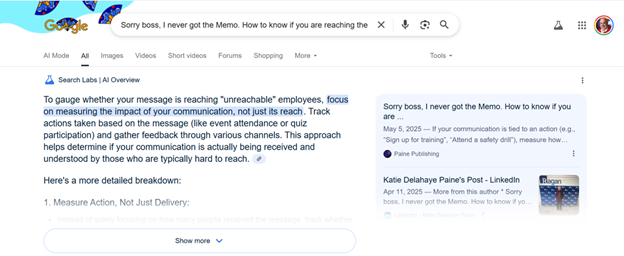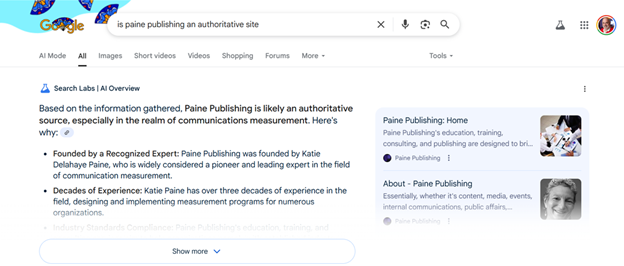I was asked recently to take a closer look at the data for a website in Google Analytics 4 (GA4).
This was for “Measurement Queen” Katie Delahaye Paine, a pioneer with over 30 years of experience in communications research and measurement, who now feels like she is flying blind.
From looking at her data in GA4, it turns out that 86% of the new users who visited her website over the last 28 days came from the “direct” channel.
That means the author of Measure What Matters can’t identify the sources of the vast majority of her website’s traffic.
So, I compared user acquisition for the last 28 days with the same period last year (matching the day of week). The good news was that total new users were up 29% year-over-year (YoY).
But here’s the bad news: Direct traffic to her site was up 126% YoY, while referral traffic was down 90%, organic social traffic was down 33%, and organic search traffic was down 28%.
This means that more than six out of seven users are now arriving on Paine’s site without a traceable referrer.
This includes situations where a user types her website address directly into their browser, uses a bookmark to access her site, or arrives from a source that doesn’t pass referrer information.
Table of Contents
Digging Deeper Into What’s Behind The Traffic Surge
So, I asked the Measurement Queen a couple of standard questions:
- Is PainePublishing.com getting a surge in traffic from “Dark Social” channels (like TikTok, WhatsApp, etc.) that don’t pass referrer data?
- Is PainePublishing.com now getting a surge in traffic from Google AI Overviews, which was not passing referrer information to GA4, but now seems to be fixed?
She replied, “I don’t even have a TikTok account and haven’t used WhatsApp in years!”
I’d call that a big no. But it also indicated that I should use GA4’s search function to discover “top landing page by users for first user default channel group of direct traffic.”
The site’s homepage was the top landing page for direct traffic, but only 18.37% of users landed there. In second place was her blog, The Measurement Advisor, which got 13.96% of the site’s direct traffic.
When I shared this data with Paine, she revealed, “I’ve been blogging more frequently.”
I’d call that a big yes. So, I just asked Google about the titles of her recent blog posts in Google’s search box.
Here’s what I saw when I Googled [Sorry boss, I never got the Memo. How to know if you’re reaching the unreachables?].

Then, I just asked Google, [Is Paine Publishing an authoritative site?].
Here’s what I saw:

Why haven’t similar insights been reported to more CMOs?
Reporting Squirrels, who primarily focus on generating reports without necessarily providing deep insights or actionable recommendations, are reluctant to highlight this type of anomaly, especially when “direct” means “We don’t know.”
So, CMOs need to rethink attribution in AI search. They need to independently verify and interpret GA4 event-based data.
And they also need to hire “Analysis Ninjas,” who excel at analyzing data to uncover hidden patterns, generate insights, and provide recommendations for business improvement.
Rethinking Attribution In AI Search
CMOs need to rethink their fundamental assumptions about attribution.
How should they attribute credit to key user actions throughout the customer’s journey toward making a purchase or completing other important actions on their sites?
They should avoid the old discussions that narrowly focused on data-driven attribution versus paid and organic last-click attribution.
Those touchpoints seem less meaningful when AI search is obscuring the sources of six out of seven of their website’s visitors.
Instead, CMOs (and important members of their team) should read “It’s Time for Marketers to Move Beyond the Linear Funnel,”
The article by the Boston Consulting Group cites force-fitting the complex array of touchpoints into a linear, funnel model doesn’t align with actual customer journeys.
This linear, funnel model can lead to missed opportunities due to poorly allocated resources or ineffective communication.
BCG says, “Marketers should instead adopt a more adaptable framework that more accurately reflects the real paths consumers take.”
BCG recommends shifting from the linear funnel to “influence maps.” But, before CMOs fly into that fog bank, they should re-examine the “expanding network of touchpoints – new streaming services, online shopping experiences, GenAI, and social platforms.”
Recognizing The Attribution Gaps That Existed Before AI
If CMOs blow up the funnel model and examine what’s in the awareness stage, they’ll see it includes radio, TV ads, magazines/newspapers, in-store announcements, word of mouth, packaging, and billboards. None of these were ever tracked in GA4.
And, if they analyze what’s in the consideration stage, they’ll see it includes video, brand sites, social media, search, sponsored content, retail media, in-app, and email. These were tracked by GA4 – until AI search started clouding over the sources of this traffic to websites.
In other words, GA4 didn’t track the awareness stage of this “multi-touchpoint landscape” even before the advent of Google AI Overviews.
And now that AI search is obscuring the sources of most of the touchpoints in the consideration stage, CMOs need to rapidly reconsider, review, revise, reassess, reconceptualize, and reimagine their assumptions about data-driven attribution.
These old assumptions may still be valid for Performance Max campaigns in Google Ads, which leverage Google’s AI to maximize performance across all of Google’s advertising channels, including Search, Display, YouTube, Discover, Gmail, and Maps.
And when an organization connects its Google Analytics property to a Google Ads account, it makes it possible to align GA4 and Google Ads conversions using the organization’s most important events.
But, according to a 2024 zero-click search study, paid search accounts for only 1% of clicks.
So, how do CMOs assign credit to SEO, content marketing, social media marketing, and communications for the 40.5% of other Google searches that produce clicks, or the 58.5% of zero-click searches?
Until Google provides a new version of Analytics that measures what matters for professionals across the entire marketing mix, CMOs will need to independently verify and interpret GA4’s event-based data.
Independently Verifying And Interpreting GA4 Event-Based Data
How do CMOs discover the critical data and strategic insights they need to successfully navigate through the fog bank surrounding the awareness stage of customer journeys?
They should conduct more old-school market research. Ironically, many brands cut their budgets for market research after Google started offering free brand lift studies to advertisers for their YouTube campaigns in March 2013.
But, CMOs don’t need to limit independent brand lift studies to asking questions about ad recall. They can ask questions about brand awareness, consideration, and purchase intent to understand the value of their entire marketing mix.
In 2019, my digital marketing agency helped the Rutgers School of Management and Labor Relations (SMLR) launch a new online master’s degree program.
We won the U.S. Search Award for Best Use of PR in a Search Campaign and were a finalist in the Best Integrated Campaign category.
We conducted pre- and post-launch surveys six months apart to show:
- The percentage of respondents who said they were “familiar with” Rutgers SMLR had increased from 13.8% pre-launch to 18.5% post-launch.
- The percentage of respondents who said they were “very likely” to recommend Rutgers SMLR to a friend or colleague had increased from 16.7% pre-launch to 19.0% post-launch.
Next, CMOs can successfully navigate through the low clouds now obscuring the touchpoints in the consideration stage by putting someone in charge of audience research as well as market research.
There are several excellent audience research tools, each with unique strengths, to help understand their needs, behaviors, preferences, and motivations.
For online behavior and digital footprints, SparkToro and Similarweb are highly effective.
For psychographic and cultural affinity analysis, Audiense and BuzzSumo are great choices.
For social listening and brand monitoring, Sprout Social and Keyhole are powerful options.
Taking Control When Analytics Falls Short
Next, CMOs should challenge their SEO, content marketing, social media marketing, and communications teams to create their own audiences in GA4 just like the ones that the paid media team is already using for remarketing campaigns.
For example, a PR audience could include users who:
- Scroll to 90% of a blog post or article.
- Download a whitepaper.
- Play at least 50% of a product video.
- Complete a tutorial.
The communications team can share their PR audiences with their colleagues in paid media, who can use Google Ads to remarket to these groups of users.
- If users scroll to 90% or more of your blog post or download a whitepaper, then they can use ads to invite them to subscribe to your newsletter.
- If users play at least 50% of a product video or complete a tutorial, then they can use ads to invite them to attend one or more in-person or virtual events.
CMOs should also ask their digital analytics teams if they have used “Explorations” this month. This is a set of advanced tools in GA4 designed to go beyond basic reports, allowing them to gain deeper insights into their customers’ behavior.
There’s no way to predict what different digital analytics teams will discover, but CMOs who feel they’re flying blind will want to know what their team saw when they used:
- User Exploration to dig into data about individual users or groups within your segments to analyze detailed user journeys.
- Cohort Exploration to study user groups with shared traits to understand behavior trends and performance over time.
- Segment Overlap to compare how user segments intersect to uncover hidden audiences that meet specific conditions.
- Funnel Exploration to track the steps users follow to complete key actions, helping you optimize conversion paths and spot performance issues.
- Path Exploration to visualize the actual navigation paths users take through your website or app.
- User Lifetime to assess long-term user behavior and value from the first visit through their customer lifecycle.
Hire Analysis Ninjas Who Excel At Analyzing Data
Finally, CMOs need to ask themselves: How did the attribution problem manage to fly under the radar for so long?
They could blame GA4’s Analytics Intelligence. Automated insights are supposed to detect unusual changes or emerging trends in their website’s data and notify their digital analytics team automatically, on the Insights dashboard, within the Analytics platform.
If the so-called Reporting Squirrels were reluctant to highlight this type of anomaly, especially when “direct” means “We don’t know,” then who is really to blame?
That’s why CMOs also need to ask themselves: How do I turn at least one of my Reporting Squirrels into an Analysis Ninja?
To encourage a Reporting Squirrel to evolve into an Analysis Ninja, CMOs must shift from asking for data to encouraging someone on their digital analytics team to actively interpret it and recommend solutions.
This also involves encouraging them to develop skills in statistical analysis, understand business context, and communicate findings effectively.
More Resources:
- Marketing Attribution: Everything You Need To Know
- A Complete Guide To B2B Multitouch Attribution Models
- B2B Lead Generation
Featured Image: Viktoriia Hnatiuk/Shutterstock


